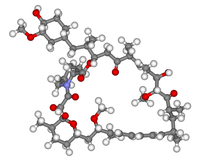
Photo from wikipedia
The field of cancer immunology is rapidly moving towards innovative therapeutic strategies. As a consequence the need for robust and predictive preclinical platforms arises just as well. The current project… Click to show full abstract
The field of cancer immunology is rapidly moving towards innovative therapeutic strategies. As a consequence the need for robust and predictive preclinical platforms arises just as well. The current project aims to establish a drug screening workflow bridging between innovative mouse models and clinical biomarker development. A total of 69 NOG (NOD/Shi-scid/IL-2Rγnull) mice were engrafted with CD34+ hematopoietic stem cells. Thereafter, tumor material from 11 different lung cancer patient derived xenograft models (NSCLC PDX) was implanted subcutaneously. Individual mice were treated with α-CTLA-4, α-PD-1 or the combination thereof. With n=1 per treatment arm and model the study design followed the screening approach of the single mouse trial (SMT). Infiltration of human immune cells was detected by flow cytometry (FC) and immunohistochemistry (IHC) in hematopoietic organs and tumor tissue. A computerized analysis for digitized whole-slide images of the samples was used to quantify the lymphocyte infiltration using color classification and morphological image processing techniques. All 3 treatment arms displayed a discrete activity pattern throughout the PDX panel. Tumor models with high tumor infiltrating lymphocyte (TIL) rates in the donor patient material tended to be more sensitive towards checkpoint inhibitor treatment as models with low rates. Numbers of TILs in the PDX detected by FC and IHC were significantly increased in the treatment groups as compared to control vehicle. In parallel, hematopoietic organs showed high (>25%) amounts of huCD45 cells in all groups and models. PDX models being sensitive towards checkpoint inhibitor treatment (responders) displayed a higher percentage of DAB+ nuclei in huCD45 IHC stains than non-responder models as determined by image analysis. Irrespective thereof, in responders as well as non-responders the treatment with checkpoint inhibitors enhanced the percentage of DAB+ nuclei. Whole-slide image analysis of the HE 2017 Apr 1-5; Washington, DC. Philadelphia (PA): AACR; Cancer Res 2017;77(13 Suppl):Abstract nr 4815. doi:10.1158/1538-7445.AM2017-4815
Journal Title: Cancer Research
Year Published: 2017
Link to full text (if available)
Share on Social Media: Sign Up to like & get
recommendations!